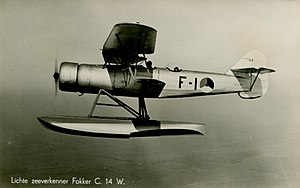Engineering:Fokker C.XIV
From HandWiki
| C.XIV-W | |
|---|---|

| |
| Role | Reconnaissance seaplane |
| Manufacturer | Fokker |
| First flight | 1937 |
| Primary user | Royal Netherlands Navy |
| Number built | 24 |
The Fokker CXIV-W was a reconnaissance seaplane produced in the Netherlands in the 1930s. It was a conventional, single-bay biplane with staggered wings of unequal span braced by N-struts. The pilot and observer sat in tandem, open cockpits, and the undercarriage consisted of twin pontoons. 11 of the 24 examples produced were stationed in the Dutch East Indies. These were later joined by 12 aircraft that had escaped to the UK following the German invasion of the Netherlands in 1940. All C.XIVs were destroyed during the Japanese invasion of the Dutch East Indies.
Operators
 Netherlands
Netherlands
- Royal Netherlands Navy
Specifications
General characteristics
- Crew: Two, pilot and observer
- Length: 9.55 m (31 ft 4 in)
- Wingspan: 12.05 m (39 ft 7 in)
- Height: 4.25 m (14 ft 0 in)
- Wing area: 31.7 m2 (341 sq ft)
- Empty weight: 1,315 kg (2,900 lb)
- Gross weight: 1,945 kg (4,288 lb)
- Powerplant: 1 × Wright R-975-E3 , 340 kW (450 hp)
Performance
- Maximum speed: 230 km/h (140 mph, 120 kn)
- Range: 950 km (590 mi, 510 nmi)
- Service ceiling: 4,800 m (15,750 ft)
- Rate of climb: 3.4 m/s (660 ft/min)
Armament
- 1 × fixed, forward-firing 7.9 mm FN-Browning machine gun in forward fuselage
- 1 × trainable, rearward-firing 7.9 mm FN-Browning machine gun in observer's cockpit
See also
Related lists
References
- Taylor, Michael J. H. (1989). Jane's Encyclopedia of Aviation. London: Studio Editions. pp. 404.
- World Aircraft Information Files. London: Bright Star Publishing. pp. File 894 Sheet 34.
 |

